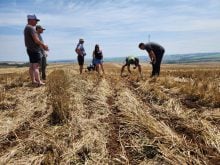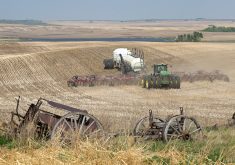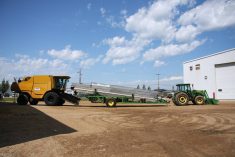Similar looking cows are huddled in similar looking pens.
However, some of the cattle don’t just resemble each other. They are identical, clear down to their genes.
Of the approximately 400 cattle in Barry Pollard’s herd of mostly Black Angus cattle, 22 are clones, genetic copies of some of the most productive livestock the world has ever known.
Pollard, a neurosurgeon and owner of Pollard Farms, said such breeding technology is at the forefront of a new era in animal agriculture.
Read Also

Gene editing digs deeper space in Canadian plant breeding
More Canadian research into crop variety development is incorporating gene editing, and one researcher notes that Canada’s regulatory approach to gene editing will help drive innovation
“We’re trying to stay on the very top of the heap of quality, genetically, with animals that will gain well and fatten well, produce well and reproduce well,” he said.
The U.S. Food and Drug Administration approved the sale of food from clones and their offspring in 2008, stating the products are indistinguishable from that of their nonclone counterparts. Japan, the European Union and others have followed suit.
The moves have stirred controversy about whether tinkering with nature is safe or ethical, prompting major food companies to swear off food products from cloned animals.
However, consumers are likely already eating meat and drinking milk from the offspring of clones, which are technically not clones, without even knowing it.
Farmers can now use cloning and other assisted breeding technologies to breed cattle that produce bigger, better steaks or massive amounts of milk, and animals that resist diseases or reproduce with clockwork precision.
Premier genes can translate to improved feeding efficiency, which results in cattle that are able to convert the least amount of feed into the most meat or milk. This results in a smaller environmental footprint.
“If you don’t need as much corn to feed your cattle, you might be able to cut back on the amount of fertilizer put out there on the countryside that might end up in a river. You can cut the amount of diesel that’s spent raising that corn,” Pollard said.
“Just like they improve the genetics of corn, so they can produce more bushels per acre. We’re trying to do that same type of thing by using cloning and superior genetics to produce more meat with less input.”
The United Nations’ Food and Agriculture Organization has said food production will need to double by mid-century to meet demand from a growing world population, with 70 percent of that growth coming from efficiency-improving technologies.
Such forecasts have prompted calls for a second Green Revolution, a rethinking of the movement championed by Norman Borlaug, who won the 1970 Nobel Peace Prize for his work in boosting grain production for starving nations.
Biotechnological advances in grain production will remain at the forefront of the global fight to alleviate hunger, although animal agriculture will likely contribute in the longer term.
“When people talk about feeding the world, reducing or eliminating hunger, I don’t think animal agriculture has much of a role to play,” said Robert Thomson, professor of agricultural policy at the University of Illinois.
“But, as people successfully move out of that extreme poverty, that’s when you get the growth in demand for animal protein, and potentially cloning could have positive benefits.”
Some animal breeds, ideally suited for arid climates, could be propagated to use grazing pastures unsuitable for crop production.
Others may be bred to resist local maladies, such as the Nguni cattle breed that can develop resistance to ticks and immunity to tick-borne diseases.
Meanwhile, a growing and more affluent population in the developing world is seen boosting demand for meat and dairy products.
Meat consumption in developing countries more than doubled from 10 kilograms per person per year in the 1960s to 26 kg near the turn of the century, according to the FAO.
By 2030, that is expected to rise to 37 kg per person. Milk and dairy product consumption has made similarly rapid growth.
Of the more than 2.4 million Angus cattle that have been registered with the American Angus Association since 2001, only 56 were clones, according to association chief executive officer Bryce Schumann.
It costs at least $15,000 to clone a cow and $4,000 to clone a sow, although improving efficiencies will likely lower those costs in coming years, said Mark Walton, president of ViaGen, a company in Austin, Texas, that provides animal cloning and genomics services.
ViaGen owns the intellectual property rights to the technology that in 1996 produced Dolly the sheep, the world’s first animal cloned from an adult cell.
ViaGen, with its partner company, Trans Ova Genetics of Sioux Center, Iowa, produces the vast majority of the clones in the United States. Other cloning companies are in Brazil, Argentina, Australia and China.
Walton said of the 102 million cattle and 66 million hogs in the U.S., “no more than a few thousand” are clones. Global numbers are around 6,000.
The most common cloning technique is called somatic cell nuclear transfer, a process in which a donor egg cell’s nucleus is removed and replaced with the nucleus and genes of a cell from the animal that scientists aim to duplicate.
That cell is then stimulated and later implanted in a surrogate mother.
Walton said cloning is costly because it is a tedious process and the technology is immature, comparable to the production inefficiencies of the early automobile industry.
Years ago, scientists were able to achieve success in only two to three percent of attempts, but ViaGen now boasts 10 to 15 percent efficiency in producing a calf. Its aim is nearer to 60 percent.
Despite the steady improvement in the technology, consumer acceptance of cloning as a viable way to produce human food remains the top hurdle for breeders and cloning companies.
A survey conducted by the International Food Information Council found that half of Americans surveyed viewed animal cloning as “not very favorable” or “not at all favorable.”
A similar number said they were unlikely to buy meat, milk or eggs from offspring of cloned animals, even if the FDA says the products are safe. Other surveys have found that nearly half of consumers have moral objections to cloning.
“When you’re genetically modifying a plant, creating a seed that perhaps has a resistance to insects, that’s different than cloning, and maybe modifying a sentient being,” said Chris Waldrop, director of the Food Policy Institute at the Consumer Federation of America.
“There are different ethical, religious and moral issues that a society has to grapple with before they move forward on such a technology.”
Large offspring syndrome also occurs more often with assisted breeding technologies such as cloning. The syndrome causes the fetus to grow too large, causing problems for the clone and the surrogate.
Opponents also say the FDA’s risk assessment was not thorough enough and a long-term, multi-generational study of cloning’s effects on food products is needed. The products should at least be labelled as derived from cloning, they say.
“The largest study looked at milk from only 15 cows,” said Jaydee Hanson, policy analyst at the Center for Food Safety, a nonprofit advocacy and research group
“Only one study used standard methods of toxicology, and that study looked at the effects of feeding 20 rats products from clones for 14 weeks…. We don’t think that cloning is a technology that’s ready yet, and we certainly don’t think it’s ready to be on your plate.”
He said the only way to avoid food from clones is to buy organic products, which by the Organic Trade Association’s definition are from only traditionally bred animals.
The U.S. Agriculture Department has asked the livestock industry to voluntarily keep clones out of the food supply for the moment, but the moratorium does not apply to progeny of clones.
Major meat and dairy companies have said they will not accept products from clones, citing the desires of their customers.
Walton said cloned animals are far too valuable as breeding stock to be used for food but added the progeny of clones are “undoubtedly already in the food chain.”
“(However), the proportion is infinitesimally small compared to the total meat supply, a tiny little drop in the ocean,” he said.
Still, ViaGen and the Biotechnology Industry Organization have helped create a supply chain management program to track clones from birth to death.
ViaGen also gives farmers the incentive to disclose when and where they cull a clone by holding a deposit until the clone’s owner can verify that the animal has been euthanized or slaughtered for meat.














